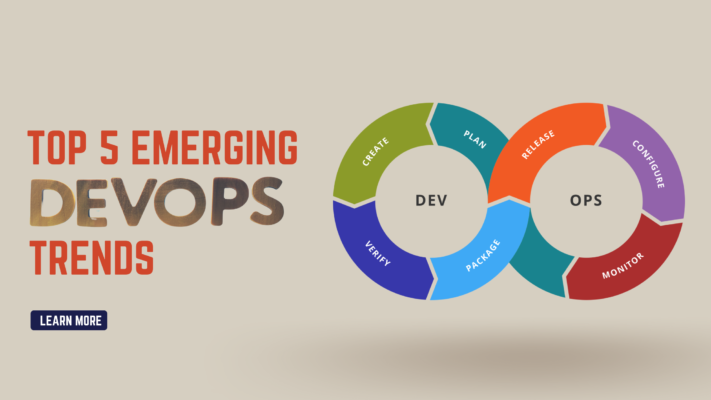
- March 7 2024
- admin
The rapid pace of technological innovation is requiring companies to adapt quickly. DevOps trends are emerging as organizations aim to increase agility, deliver higher-quality software faster, and improve productivity.
In this comprehensive guide, we’ll explore the latest DevOps trends transforming software development and operations. We’ll look at adoption statistics, real-world examples, expert insights, and key strategies to prepare your organization.
The Acceleration of DevOps
DevOps adoption has steadily increased over the past decade. Various surveys highlight the growing importance of DevOps trends:
- Puppet’s 2022 State of DevOps report found that 96% of tech professionals are implementing DevOps in some capacity. 46% have transitioned fully.
- 80% of organizations will implement DevOps workflows by 2022, per Gartner.
- 95% of organizations surveyed by GitLab practice DevOps to some extent today.
DevOps is becoming the new normal. What’s driving this acceleration? Primarily, the need for speed.
DevOps enables faster software releases. Organizations utilizing DevOps deploy code 46x more frequently and recover from incidents 24x faster, per Puppet’s research. Faster deployment directly correlates with higher revenue growth.
As technology competition heats up across every industry, companies are relying on DevOps trends to rapidly deliver new features, updates, and innovations. Adopting DevOps is no longer optional.
Top 5 Emerging DevOps Trends
Let’s dive into the top 5 emerging DevOps trends organizations need to know for 2023 and beyond:
1. Shift Left Security
Shift left security involves integrating security practices earlier into the DevOps lifecycle. Rather than just scanning for vulnerabilities post-release, security is built into the CI/CD pipeline.
74% of organizations now integrate security into their DevOps workflows, reports GitLab. Benefits include reducing risk, preventing costly delays, and automating policy enforcement.
Developers also gain visibility into security issues before their code ever reaches production. This empowers them to resolve issues faster.
2. GitOps Adoption
GitOps automates infrastructure management and deployment using Git principles. Infrastructure-as-code, along with continuous delivery pipelines, can be version-controlled just like application source code.
55% of organizations have already adopted GitOps, per Canalys. Benefits include improved collaboration between developers and ops, plus change management and auditability through commits.
As infrastructure complexity increases, GitOps is becoming essential for managing configuration drift at scale. It brings DevOps consistency to infrastructure changes.
3. NoOps & Autonomous Operations
NoOps (or No Operations) removes the need for humans to perform routine operational tasks manually. Instead, operations are fully automated using intelligent bots, observability pipelines, and AIO platforms.
Gartner predicts that by 2025, 10% of enterprises will operate with NoOps capabilities across cloud environments. The goal is to push organizations closer to autonomous operations where systems self-manage and self-heal.
NoOps enables engineers to focus on higher-value initiatives rather than repetitive manual work. Autonomous operations can eliminate costly human-induced incidents.
4. DevSecOps Maturity
DevSecOps expands DevOps by deeply integrating security at every stage. 470% growth is expected in DevSecOps spending through 2025, per 451 Research.
Key capabilities like automated security scanning, infrastructure-as-code analysis, and policy enforcement are becoming essential. Platforms like Snyk, Aqua, and Checkmarx enable baking security into pipelines.
As attacks increase, high DevSecOps maturity directly correlates with reduced security risks, per Ponemon Institute research. 86% of security professionals expect developers to own security within their workflows.
5. Focus on Developer Experience
Improving developer experience (DX) is a rising priority. 88% of organizations recognize developer experience as vital to their business success, per GitLab.
Developers expect fast, reliable pipelines and collaboration between teams. Solutions like GitHub and GitLab centralize workflows into a consistent developer experience.
Better DX also correlates strongly with team productivity and software delivery performance, as shown in DORA’s research. Focusing on developer experience serves the whole business.
Real-World Examples of DevOps Transformations
These inspiring case studies demonstrate the power of embracing DevOps trends at leading companies:
Target
- Improved developer productivity by 20%
- Reduced operations costs by 10%+
- Deploys updates as often as 50x per day
Target adopted DevOps, along with microservices and cloud infrastructure, to accelerate its e-commerce systems. Developers gained autonomy and productivity while losses due to incidents dropped significantly.
Petco
- Deploys up to 5,000 code changes per week
- Reduced deployment time from hours to minutes
- Improved system reliability by 22%
Petco transformed its rigid, painful legacy systems using containers, CI/CD automation, and a cloud-native approach. They can now build innovative customer experiences rapidly.
Nordstrom
- Grew online sales by 25% YoY
- 99.995% website uptime reliability
- 380+ code releases per week
Nordstrom credits their DevOps investments with growing e-commerce and improving customer satisfaction. Their cloud automation and CI/CD pipelines enabled high velocity.
Best Buy
- 4,000 code deploys per week
- 50x faster deployments
- Improved lead time for changes by 60-80%
Best Buy’s DevOps efforts increased its organizational agility. Automation and continuous delivery practices sped up quantifiable business results.
Capital One
- Grew from 700 to 16,000 application containers
- Improved stability, lowered change failure rate
- Freed up developers to deliver more business value
Capital One uses public cloud, microservices, CI/CD pipelines, and an API-first approach to achieve speed and stability simultaneously.
These examples highlight what modern DevOps practices make possible – the ability to deliver better software faster for business growth.
Expert Guidance on Navigating DevOps Trends
Industry experts stress the importance of embracing DevOps trends today:
Gene Kim, Author of The DevOps Handbook:
> “DevOps capabilities are how organizations will be able to quickly recover and thrive. Companies mastering DevOps will have a permanent competitive advantage.”
Mirco Hering, Global DevOps Thought Leader:
> “Companies not adopting DevOps practices will perish. The expectations on software speed and quality have increased exponentially.”
Dr. Mik Kersten, CEO of Tasktop:
> “We’ve hit an inflection point with DevOps becoming mandatory. The capabilities needed – automation, collaboration, security – underpin the digital business.”
**Kaspar Rohloff, Co-Founder of AIOps Leader BigPanda:**
> “Driving meaningful change requires a platform enabling end-to-end visibility, automation, and intelligence across the software delivery pipeline.”
These experts emphasize that DevOps trends must become strategic priorities. Companies lagging in their adoption risk major competitive disadvantages.
8 Keys to Unlocking Your DevOps Potential
Based on the latest trends and expert insights, here are 8 recommendations to accelerate your DevOps journey:
- Obtain executive buy-in. DevOps requires strategic realignment. Executive sponsorship is essential.
- Foster a collaborative culture. Break down silos between teams. Shared ownership and open communication underpin DevOps.
- Standardize pipelines as code. Automate CI/CD workflows using declarative pipelines for speed and consistency.
- Extend automation everywhere. Automate deployments, infrastructure, configurations, and policy enforcement.
- Embrace Shift Left security. Make security intrinsic by embedding it into pipelines and processes early.
- Centralize monitoring and visibility. Correlate data from across tools for end-to-end observability and intelligent action.
- Improve developer experience. Focus on developer productivity by removing roadblocks and frustrations.
- Keep iterating. Continuously improve and optimize processes through feedback loops and Site Reliability Engineering.
The Future is Flexible, Fast, and Focused
DevOps trends demand organizations become more flexible, deliver faster, and focus on customers. Companies that transform around these new capabilities will gain long-term competitive advantages.
By embracing automation, visibility, collaboration, and developer empowerment, organizations can navigate change and unlock innovation. Prioritizing DevOps sets you on the path to becoming a modern digital business.
Want expert guidance on your DevOps journey? The team at Upcore Technologies specializes in DevOps consulting, implementation, managed services, and training to help you transform.


